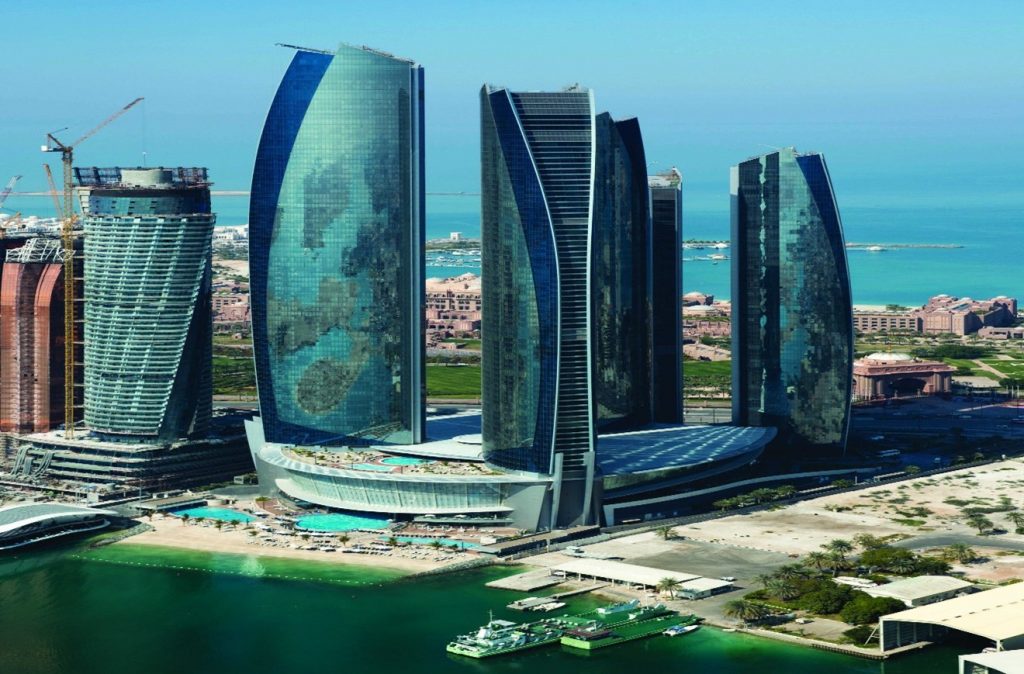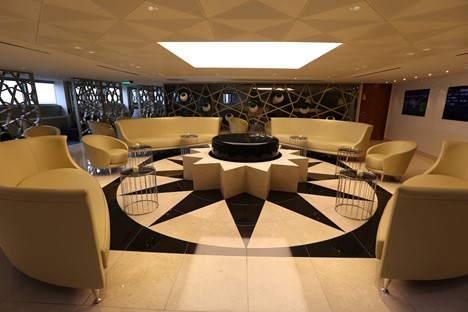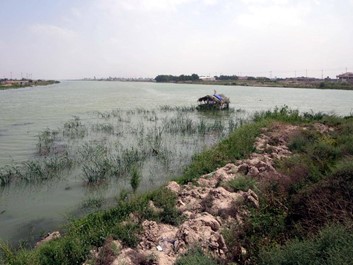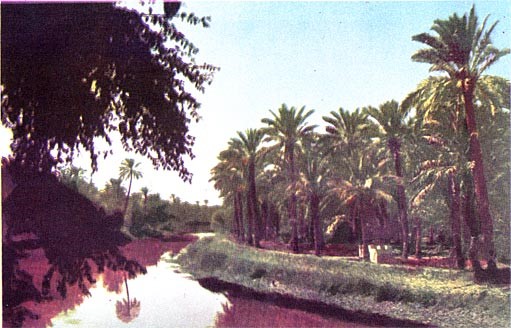

Date: 10/23/2020
Author: Kent Moors, Ph.D.
Henry Kissinger once said that upon choosing to enter geopolitics expect your biological clock to be the first to go.
It is at times like this that I know exactly what he meant. It is early morning as I write this while watching the sun come up over the Arabian Sea. But being eight time zones later than East Coast US, the internal clock again feels the strain.
And I am hardly finished.
As readers of Classified Intelligence Brief are aware, I began in Switzerland earlier this week. The talks have now moved to Abu Dhabi, the capital of the United Arab Emirates. We arrived in the early hours of this morning (local time) and our sessions renew shortly.
This round of my meetings takes place in the middle right building of the five-tower Etihad Tower complex below, the striking focal piece in a remarkably remade city center.


You may remember these towers were used as a location for the 2015 film Furious 7. Van Diesel and the late Paul Walker stole a Lykan HyperSport (the first limited edition sports car built in the UAE) and drove it through three of them, including the one I call home when in the city.
It is the Jumeirah at Etihad Towers where our folks have taken the entire small and secure 42nd executive suite floor, three levels down from our equally secure private meeting room. Once again, as in Lausanne, I can provide a photo only when there is no one else in the room.


That is a Picasso on the back wall.
Intentions this time around are to secure some consensus from local Persian Gulf energy holdings and finance sources (including the Abu Dhabi Investment Authority, the world’s third largest sovereign wealth fund) on proposals ironed out in the Swiss sessions discussed in Classified Intelligence Brief earlier this week.
Now everybody knows where our Gulfstream V will be heading next, given the diplomatic tiff preventing Iranians from attending any meetings in the UAE. Tomorrow, we fly to the impressive Hamad International Airport in Doha, the capital of Qatar, for a parallel session with Iranians, Qataris and others. Once again, it is held in another private room. This one is encased in concrete inside the airport’s restricted (and guarded) Al Safra First Class Lounge.


I have used this room before for secure discussions. It is an easy matter for participants to fly in for a meeting and then head back home with a minimum of inconvenience.
Inconvenience is something I need to avoid. Iranian animosity against the US is at the highest level I have witnessed in years. For what it is worth, the European individuals I am working with on this mission all hail from countries that still support the Joint Comprehensive Plan of Action (JCPOA), the nuclear accord the UK, France, Germany, the EU, Russia, China, and the US signed with Iran in 2015.
Washington announced it was pulling out of the accord in May of 2018, renewed sanctions against Iran, and ushered in a firestorm of diplomatic anger. I recognize that the folks at the Hamad meeting will not agree to anything at this point, especially so soon before the US elections.
But my objective is to lay groundwork for possible ongoing negotiations in the future. One small step, then hopefully another.
So, this morning, as in other occasions, I am marking time. But that simply means my mind tends to wander back in time.
Recent events in the Persian Gulf seem like déjà vu. More than a few personal reminiscences come to mind. At the dawn of another busy morning, I look down at the waters below me and recall the first time I saw how Iranians react when they are pushed up against a wall. The tale below carries a strident lesson about consequences where oil is fought over. It also always provides me a strong internal counsel in meetings such as that anticipated in Doha.
It took place here. This is the Shatt al-Arab (“River of the Arabs”). For 50 miles or so it forms the border between Iraq and Iran.


Cutting across some of the prime oil producing acreage in the world, it has been a bone of contention between them for centuries. Formed by the confluence of the Tigris and Euphrates, it flows southward into the Persian Gulf. Just below the southern Iraqi city of Basra (the picture above), the Shatt al-Arab is about half a mile wide. But in other areas, like the photo below taken just before the events I will discuss shortly, there can be only a few hundred feet of marsh separating the two.


It would loom large in the 1980-1988 Iran-Iraq War, which pitted the fourth largest army in the world (Saddam Hussein’s Iraq) against a revitalized Shiite theocracy (Iran).
And that’s where I came in.
Before 1985, the focus of my intelligence work had been either Southeast Asia (following my counter intel work in Vietnam) or in Europe and elsewhere against Soviet interests. But the Shatt al-Arab was my first taste of what spying meant in a region that remains a powder keg today.
On September 22, 1980, Saddam launched his troops across the Shatt and attempted to seize Iranian oil production. The other side of the water was just emerging from a religiously inspired revolution that toppled the Shah, brought to power Ayatollah Khomeini, and supposedly weakened the country.
Well, nobody bothered to tell the Iranians that.
What transpired was a brutal stalemate. Massive military casualties on both sides, vast destruction of oil fields, indiscriminate use of chemical weapons by Iraq, and a huge number of civilian deaths. Upward to a million fatalities total, most of them in Iran. Even today, just about one of every two Iranian families had somebody killed or injured during the period between the 1979 Revolution and the end of the Iran-Iraq War on July 20, 1988.
After the takeover of the US Embassy in Tehran and the American hostages crisis, there was American support for Iraq in the early stages of the war, despite the rather clear fact that Saddam had invaded Iran.
Initially, American satellite and other intel was provided to the Iraqi army as it moved across the Shatt. Later, several events took place (which I still cannot comment upon) that prompted the US intel community to provide support for the Iranians. For some, this was simply guaranteeing that each would damage the other and American regional interests in the region would be protected thereby.
The stalemate became a nasty modern version of the World War I trench warfare of a century ago. By mid-1987, there was movement toward negotiations. But both sides attempted to grab strategic territory in advance of any cease fire, much like what happened at the end of the Korean War.
That set the stage for the following personal experience.
My responsibility was to provide intel support in a variety of ways to decisions about what we would share with whom. By 1986, that included erstwhile allies in Europe and MENA (Middle East North Africa) who now had their own interests to protect.
I am still unable to discuss most field locations for my assignments during this time, but some of the operation occurred at a joint intel planning center outside DC. It was during a stint there that the “Brown Snake” emerged.
We knew that Iranian forces were massing near the Shatt for a last pre-negotiation push into Iraq. The intent was to capture territory Teheran could then annex when the hostilities were over.
Satellite flyby showed at least 60,000 troops were dug in on the Iranian side of the (at that location) narrow waterway. But then something else emerged. Just to the west of the troops a long undulating brown strip would occasionally appear in the recon photos, on again, off again.
Nobody had any idea what this “brown snake” was. So, we brought in the curious specialists we nicknamed the “crateologists.” These guys usually could tell you what was in anything crate size or bigger emerging from IMINT (imagery intelligence).
I remember a few months earlier one of these folks looked at a satellite picture and proclaimed “simple, that box has replacement parts for an F-14 Tomcat.” He was right, of course. The Iranians at the time were flying the remnants of the Shah’s military aircraft. Those were primarily American and that left Tehran with having to scrounge parts elsewhere in the world (since, aside from the odd Iran-Contra affair, nobody in Washington would provide them with spare parts).
Anyway, this time the crateologists had no idea what the snake was. I had only one other option. That was to dispatch HUMINT (human intelligence) to eyeball the situation. This almost certainly meant the agent I sent in would not survive. Was the intel important enough to sacrifice a life?
It is one of the decisions that stays with me forever. They all seem to have “collateral” consequences. The intel was obtained. The agent’s family was later compensated. He was a 26-year-old Iraqi. He had a name, by the way, Mustafa, and he left three children. His body was never recovered.
I was quite unprepared upon receiving the report. The brown snake appearing and then disappearing in the photos were thousands of burial sacks, held above the heads of thousands of Iranian students. Later, we would determine that some of them were not yet in their teens.
The function of each was to walk into Iraqi military fire and die so that the soldier following behind had a human shield for his advance. As nearly as we could determine, none of them survived when the battle was over. But Iran had “captured” a thin strip of marshland on the other side of the Shatt.
Made no difference in the end. That land was given back to Iraq anyway in the post conflict negotiations.
During our evaluation of what was occurring, I recall a two-star’s reaction to the student convoy. He turned to nobody in particular and said, “I hope we never have to fight those bastards.”
It is now more than three decades later. We have been in Afghanistan longer than any war in US history and as a nation are still coming to grips with the Iraqi campaign. With apologies to Cicero, this certainly seems a region that is “taxing our endurance.”
But the “brown snake” remains a backdrop for every meeting I have with Iranians, including the one coming over the weekend.
Next week, CIB will share with you what happened in these final sessions and how what was discussed may have a major impact on profits coming for Main Street investors.


Dr. Kent Moors
This is an installment of Classified Intelligence Brief, your guide to what’s really happening behind the headlines… and how to profit from it.
Dr. Kent Moors served the United States for 30 years as one of the most highly decorated intelligence operatives alive today (including THREE Presidential commendations). After moving through the inner circles of royalty, oligarchs, billionaires, and the uber-rich, he discovered some of the most important secrets regarding finance, geo-politics, and business. As a result, he built one of the most impressive rolodexes in the world. His insights and network of contacts took him from a Vietnam veteran to becoming one of the globe’s most sought after consultants, with clients including six of the largest energy companies and the United States government.
Now, Dr. Moors is sharing his proprietary research every week… knowledge filtered through his decades as an internationally recognized professor and scholar, intelligence operative, business consultant, investor, and geo-political “troubleshooter.”
This publication is designed to give you an insider’s view of what is really happening on the geo-political stage. You can sign up for FREE to Classified Intelligence Brief and begin receiving insights from Dr. Moors and his team immediately.
Just click here – https://classifiedintelligencebrief.com/






